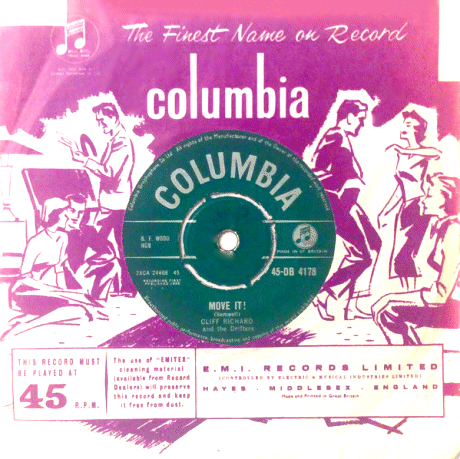Sixties
City presents
a wide-ranging series of
articles on all aspects of the Sixties, penned by the creator of the iconic
60s music paper Mersey
Beat
|
Sixties
City presents
a wide-ranging series of
articles on all aspects of the Sixties, penned by the creator of the iconic
60s music paper Mersey
Beat
|
|||||
|
 |
'Move It',
by Cliff Richard was issued on Columbia DB 4484, written by Ian 'Sammy'
Samwell and produced by Norrie Paramor. "I think the first English record
that was anywhere near anything was 'Move It' by Cliff Richard, and before
that there'd been nothing." - John Lennon. 'Move It' was one of the first
great British rock and roll records and it has been chosen by the Rock and
Roll Hall of Fame as one of the "500 Records That Shaped Rock and Roll".
Cliff Richard formed his first group The Quintones, a vocal outfit, while
still attending Cheshunt Secondary Modern School. On leaving school he joined The Dick Teague Skiffle Group and then formed his own band with drummer Terry Smart and guitarist Norman Mitham called Harry Webb & The Drifters. John Foster spotted them in a Hoddesdon pub and offered to be their manager. Foster talked his parents into advancing him £10 to have a demonstration record made and the group went to HMV's record store in Oxford Street and cut the numbers 'Breathless' and 'Lawdy Miss Clawdy'. In July 1958 Foster organised an appearance for them to appear in a talent contest at the Gaumont, Shepherd's Bush, where he arranged for an agent, George Ganjou to see them. Ganjou then took their demo disc to record producer Norrie Paramour at EMI's Columbia label and he agreed to audition them. By that time they had been joined by Ian 'Sammy' Samwell on lead guitar and changed their name to Cliff Richard and The Drifters (the name Richard was in dedication to Little Richard). 'Sammy' had approached them even though he was in the RAF and stationed at Hendon. However, because his mother was ill he was allowed to live at home on compassionate grounds. Also, his stint as a national serviceman was coming to an end. On August 9th, 1958 they signed with EMI and Cliff left his job at the Atlas Lamps factory in Enfield. The group began a four-week residency at the Butlin's camp in Clacton-on Sea. Their guitarist Norman Mitham quit the group and Samwell took over on bass. While at Butlin's Ken Pavey, a professional guitarist who worked at the camp, stood in on guitar. Their debut single 'Schoolgirl Crush' c/w 'Move It' was issued on August 29th. 'Schoolboy Crush' was a cover of a Bobby Helms release. Samwell penned the b-side in July 1958. He had his guitar and was travelling to Cliff's house for rehearsals. Sitting on the upper deck of a Green Line bus travelling between Colney and Cheshunt, he worked out the guitar intro, thinking, "This is where the song should start". He wrote down the words as they came on the only piece of paper that came to hand, an envelope for his guitar strings. He only had time to finish off one verse, so Cliff sang it twice on the record! Part of the lyric was based on the reports in newspapers that rock and roll was a short-lived phase and would soon die out, which explains the line 'They say it's going to die'. At the recording session Paramor insisted on getting two session players Ernie Shear and bassist Frank Clark to ensure a stronger sound. The studio session took place on July 24th in Studio 2 at Abbey Road. Norrie Paramor produced it and the engineer was Malcolm Addey. The session took place between 7pm and 10.30pm and the musicians were: Cliff Richard lead vocal; Ernie Shear and Ian Samwell, guitar; Frank Clarke, bass; Terry Smart, drums; The Mike Sammes singers, backing vocals. A few days later the group were on a package tour with The Kalin Twins. Since Mitham had left they needed a new guitarist and Foster set off to the 2 Is coffee bar in Old Compton Street, London, looking for a guitarist called Tony Sheridan. He couldn't find Sheridan but met up with Hank Marvin and offered him the job. Marvin would only agree to join the group on tour if his partner Bruce Welch was taken on as rhythm guitarist. Music publisher Franklyn Boyd had brought the 'Schoolboy Crush' number to Paramor and was plugging the record. He played it to Jack Good, the influential producer of the television show 'Oh Boy'. Good said the better number was 'Move It' and booked the group on the show on the strength of it. On September 13th the group made their debut on the show and Cliff performed 'Move It', although Good insisted that Cliff sing without his guitar and minus his sideburns! Other disc jockeys recognised the potential of 'Move It' and EMI decided to make it the A side. Within two weeks of the 'Oh Boy' performance the record had entered the New Musical Express chart at No.28. By November 'Move It' was number 2 in the charts, behind Connie Francis with 'Stupid Cupid'. It was the first charting single from the 17-year-old singer and was to reappear many years later in an updated version. Sammy finally finished his second verse to the number in 1995. He then sent it to Hank Marvin, who lives in Australia. Hank was already planning a new instrumental album but sent the new lyrics to Cliff. Straight away, Cliff laid down a vocal track in a British studio and sent the tape off to Hank in Australia and the new version, with Cliff's vocal, appeared on 'Hank Plays Cliff'. Later that same year Hank performed the new version of 'Move It' before Queen Elizabeth II at the Royal Variety Performance. |
|
Article
Text
UK
web hosting by
|